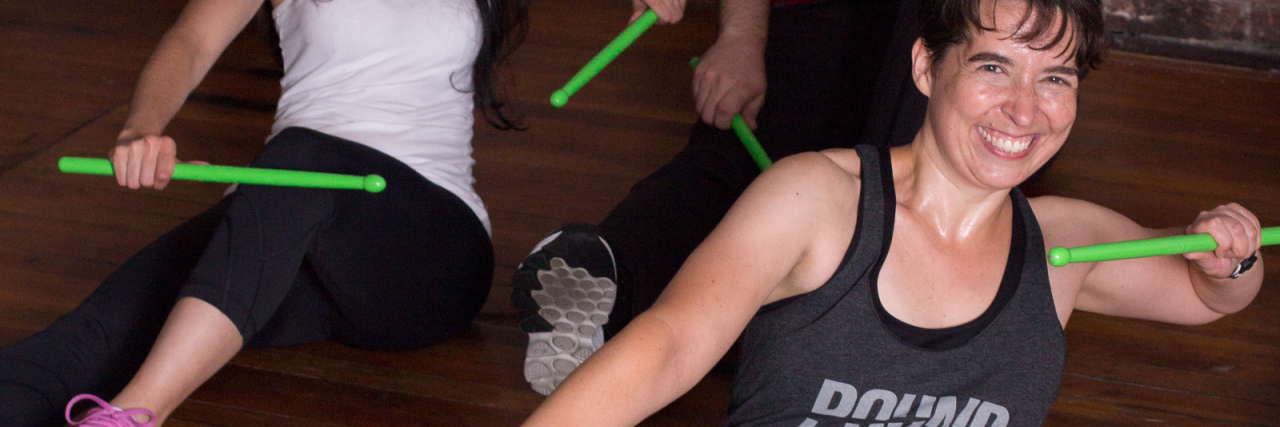Always check with your health care professional before starting an exercise regime. Pace yourself and start slow if you haven’t been working out regularly. Stop if you feel nauseated, dizzy, have chest pain, an irregular heartbeat or any sharp pains or cramps.
Before I got sick, I went to the gym five days a week. Before I got sick, I fell in love with a workout and I trained and practiced and took classes until I was allowed to teach it. Before I got sick, I taught a weekly hour-long group fitness class and I loved every minute of it.
When my body would no longer allow the commute to the gym, much less the energy for me to do an all-out workout while yelling commands and encouraging a class of people, I had to seek out alternatives. I control my mild generalized anxiety disorder (GAD) and insomnia through exercise, and losing that to multiple sclerosis was not good for my mind or body.
I sought out home workout options I could do with minimal equipment in my bedroom. YouTube and a monthly subscription to a fitness app with 30-minute video workouts are what saved me from sedentary anxiety. But as I worked out in the safety of my own home, I realized how many times I was adapting the workout to my body in ways the instructor was not talking about. From my own background in group fitness instruction, I knew tricks and tips that were not necessarily obvious to everybody out there who could benefit from some exercise.
For example, every exercise can be adapted to be low impact. A common misconception is that low impact exercise is easy, but it just means at least one of your feet stays on the floor at all times. Squats are low impact, but can definitely work up a sweat. Low impact can be less cardio intense, but more importantly, it is easier on joints. To adapt a high impact move, if the person in the video is running, march in place instead. If they are doing squat jumps, just do squats or do a squat followed by a heel lift to work the calves. If they are doing jumping jacks, do just the arms, or do the arms and alternative tapping out one foot at a time. To get your heart rate up without jumping, move your arms a lot, especially over your head, move quickly without taking both feet off the ground at once, and get low in your squats or lunges.
Planks and push-ups can be tough if you have muscle weakness. Often, videos will give you the option of doing them from your knees, but sometimes that’s still too intense. Another option is to use a countertop or wall. Stand a couple of feet away, squeeze the muscles of your butt and core to keep your whole body stiff and straight from head to foot, then lean towards the wall, coming up on your toes. If it is too easy, step further away or find a lower counter or the seat of a chair. This adaption is also good if your wrists start hurting before anything else on these moves.
If you are doing a workout with a lot of balancing on one leg and that’s not possible for you that day, keep your weight on just one leg, but put the other foot lightly on the ground. And one of the joys of working out at home is that there’s no one there to judge you, so use whatever tools you need: touch a wall or use the back of a chair so you can lift the leg.
One video I like has you lying on your back in bridge position (shoulders on the ground, legs bent and feet flat, butt off the ground), then putting one leg into the air and pulsing so your butt drops and raises by a couple of inches. It is too much for me at this point, but just holding the bridge position is a good challenge for me. Simplify or do partial moves whenever that works better for you. Any part you can do is a win!
Another option for fatigue, pain in the legs, joint problems and so on is to get a sturdy chair, sit on the edge if you can, get your core muscles involved by tightening everything like you are about to be hit in the stomach, and then imitate the movements of the instructor while staying seated. March your legs, swing your arms, and don’t worry about how it might look! I especially like this for boxing-style workouts.
Doing a safe workout that works for you is more important than doing the move exactly as shown. Pay attention to instructions that involve safety, try to engage the right muscles, and keep moving, even if it is just marching in place while the video counts off burpees. Before I got sick, a good workout meant doing every squat deep and doing every jump high. Since then, my body has changed, my needs have changed, so my workout has changed. A good workout is any where I get moving and get sweating. May it be so for you, too!
Image via contributor

